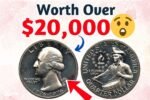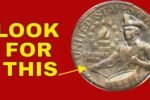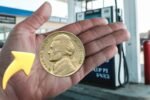Rare: The humble Lincoln Wheat Penny has once again ignited national curiosity, thanks to a rare variety that has sold for up to \$174,000. What was once loose change now holds legendary status among coin collectors. The very idea that such a penny could still be out there, circulating unnoticed, has transformed everyday activities like sorting through jars or getting change at the store into modern-day treasure hunts.
A Historic Coin with Presidential Origins
The Lincoln Wheat Penny was first minted in 1909, commemorating the 100th anniversary of Abraham Lincoln’s birth. Its release marked the first time a real person’s portrait appeared on a U.S. circulating coin. Sculpted by Victor David Brenner, the coin features Lincoln’s profile on the obverse and two wheat stalks on the reverse—an homage to America’s agrarian roots. This classic design remained in use until 1958, after which the Lincoln Memorial replaced the wheat design. Over its nearly five-decade run, billions of these coins entered circulation.
Why Is One Penny Worth \$174,000 ?
The answer lies in rarity, historical context, and condition. The penny commanding a \$174,000 price tag is most likely a 1943 Bronze Wheat Penny a rare mint error created during World War II. That year, to save copper for wartime materials, the U.S. Mint switched to zinc-coated steel. However, a few bronze planchets from 1942 were mistakenly used, resulting in a small number of 1943 bronze pennies.
Only 20–40 examples of these rare coins are believed to exist, and their extreme scarcity has made them some of the most sought-after coins in American numismatics. Other high-value varieties include the 1944 Steel Penny, 1909-S VDB, and the 1955 Doubled Die Obverse, each commanding thousands to hundreds of thousands depending on their condition.
The Role of Condition in Coin Valuation
Collectors place enormous value on coin condition. Even rare coins lose significant value if worn or damaged. Grading agencies assess coins using criteria like:
- Surface preservation
- Luster
- Strike clarity
- Eye appeal
A mint-condition coin graded MS-65 or higher can fetch multiple times more than a similar coin with moderate wear. It’s not just what coin you have, but how well it’s survived over the decades.
What to Look For in a Valuable Lincoln Wheat Penny
Want to know if you’re holding a treasure Here’s what to check:
- Date: Key years include 1909, 1914, 1922, 1931, 1943, 1944, 1955, and 1958.
- Mint Mark: Look below the date for “D” (Denver), “S” (San Francisco), or no mark (Philadelphia).
- 1943 Bronze Penny Test: Use a magnet. Steel pennies stick; bronze ones don’t.
- Weight Test: Bronze pennies weigh ~3.11 grams, while steel ones weigh ~2.7 grams.
- Visual Inspection: Check for doubled letters, misaligned strikes, or repunched mint marks.
Even minor errors can result in major value if the coin is genuine.
High-Profile Auction Sales That Made Headlines
Recent auctions have underscored the Wheat Penny’s status as one of the most collectible coins in U.S. history:
- A 1943-D Bronze Penny sold for \$1.7 million
- A 1944-S Steel Penny fetched \$373,750
- A 1909-S VDB Penny in top condition brought \$117,500
- A 1955 Doubled Die Penny reached \$114,000
While \$174,000 is a high number, it’s well within the realm of documented sales for rare, graded examples. These prices reflect a perfect combination of rarity, historical appeal, and exceptional preservation.
Is a \$174K Penny Still in Circulation ?
It’s unlikely but not impossible. Experts estimate that some rare Lincoln Wheat Pennies are still undiscovered, either lost in household collections or even circulating in change. Many error coins look deceptively normal, and unless you’re specifically searching for signs, you might miss them.
Collectors recommend routinely checking your pocket change, especially if you come across wheat reverse pennies, which stopped minting in 1958. There’s a remote but real chance you could stumble upon a life-changing discovery.
How to Authenticate a Rare Penny
Think you’ve found something special ? Don’t clean it, and don’t sell it until it’s been professionally authenticated. Due to their high value, counterfeit Wheat Pennies are widespread. Common scams include:
- Copper-plating 1943 steel pennies
- Altering dates on common coins
- Fake doubled dies
Use reputable services like:
- PCGS (Professional Coin Grading Service)
- NGC (Numismatic Guaranty Corporation)
These organizations verify authenticity and provide grading documentation, which dramatically increases your coin’s marketability and price.
Educational and Historical Value
Even if you never find a \$174,000 coin, searching for Wheat Pennies can be incredibly educational. It offers lessons in:
- American history
- Economic policy
- Minting technology
- Wartime production challenges
It’s one of the few hobbies where anyone, regardless of age or income, can actively participate and learn while doing. Many collectors trace their beginnings to finding their first Wheat Penny in pocket change.
The Community of Coin Collectors
Coin collecting isn’t just about money it’s also about community, connection, and passion. From local clubs to global forums, collectors trade, sell, and share stories. Whether you’re building a serious collection or just exploring a new hobby, there’s a welcoming space in the numismatic world.
The thrill of possibly uncovering a six-figure penny continues to attract new generations of treasure hunters, ensuring that the Lincoln Wheat Penny legacy lives on.




